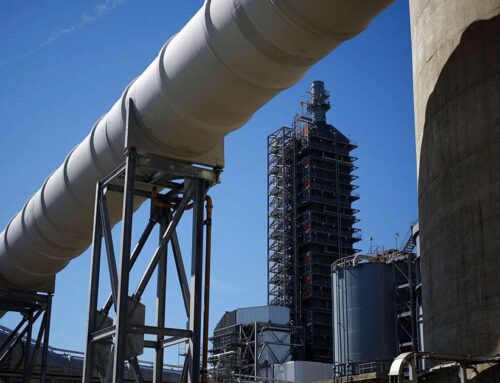Floating Solar On Lake DeForest – Brilliant Innovation Or Needless Complication – Rockland
November 20, 2025
|
RCBJ-Audible (Listen For Free)
|
Reflections On Energy, Environment, And Solutions That Shape Our Local Future
By Christine Toth
On a freezing December morning, a small group of us parked nearby. Bundled in coats and hats, we ventured out with binoculars onto the middle causeway at Lake DeForest. As in years past, we spotted dozens of fascinating creatures on the water – mergansers.
Male Hooded Mergansers are striking black-and-white ducks with a fan-shaped crest. Their serrated bills mimic their dinosaur ancestry. Female Common Mergansers look like the punk rockers of winter waterfowl. They nest in tree cavities in Canada and New England, their chicks leaping from high tree cavities — landing on the ground or directly in the water below — at their mother’s call, and later migrate south to open water like Lake DeForest. Each winter, they return here faithfully — regulars on Rockland Audubon’s Christmas Bird Count.
Numerous species have been observed breeding or stopping over at Lake DeForest. Some sightings include Black-crowned Night Herons, Great Egrets, Snow Buntings, Common Loons, Bald Eagles , and Semipalmated Sandpipers. This year, the reservoir drew attention not only for its birds but for a new idea taking shape on its surface: floating solar panels.
The closure of Indian Point Power Plant ended a long-lived nuclear-generating site but also disconnected one of our region’s largest sources of carbon-free electricity. The plant’s shutdown in 2021 was not a technical failure but a political and policy decision part of New York’s move toward renewables. Its decommissioning raised new issues, including plans to release wastewater into the Hudson — a reminder of the challenges of closing the carbon-free facilities of the past while going after the renewables of the future. The plant’s closure hits home for me because my mother worked at Indian Point as a nuclear engineer. But from a conservation standpoint, the real question now is what comes next.
There has been an emerging idea about floating solar arrays on Lake DeForest, which promises renewable energy but also demands specific design that avoids ecological trade-offs. Floating solar may not be a bad idea if it’s done carefully. With thoughtful design — leaving open water for birds to land, using non-reflective panels to prevent collisions, and maintaining buffer zones around nesting areas — it could provide clean energy without disturbing much land. Separate from the panels, small vegetated islands could provide birds with safe places to rest. Some studies suggest that floating panels could slightly boost power generation by staying cooler and might even slow algal growth by shading surface water. However, installation on reservoirs would be complex and understanding the impact on water quality, aquatic life, and migrating birds requires more study.
The concept of floating solar also raises questions about traditional solar. Solar canopies could be concentrated in developed areas like along Routes 59 and 303 in Rockland — and along so many similar corridors across the region — vast parking lots stretch beside strip malls, none of them currently shaded by solar panels. It’s easy to imagine modern, visually appealing canopies there generating clean power while reducing snow-removal needs and protecting shoppers from the elements. Compared with installing panels over water, solar on asphalt should be simpler: no disturbance to aquatic life, no need to anchor structures in a reservoir. If local zoning stands in the way, that’s something communities can change. The space is already built; we simply have to decide to use it wisely.
Globally, society is still spinning its wheels on sustainable energy. But sustainability isn’t only about what powers our lives, but how we frame our lifestyles around energy. Nationally, we’ve been slow to invest in public transportation, walkable neighborhoods, safe bike routes, and local economies that shorten the distance between home and work. World leaders and communities must decide to act boldly, but the change in course is difficult when we often behave as if human-made climate change were up for debate. Certain national leaders continue to dismiss the science, and the media has often framed the issue as a matter of opinion. But climate change isn’t a philosophy or a belief system; it’s basic physics. Carbon dioxide traps heat — and humanity releases billions of tons of it into the atmosphere each year, a truth as measurable as the boiling point of water.
When in 2006 An Inconvenient Truth brought climate change into the spotlight, it wasn’t new science but a century-old warning. By 1896, Swedish scientist Svante Arrhenius had already calculated that increasing carbon dioxide in the atmosphere would warm the planet. Today, as New York searches for new ways to generate clean energy — from floating solar arrays on reservoirs to canopies over its vast parking lots — the challenge shouldn’t be understanding the problem but choosing solutions that reduce emissions without creating new environmental problems. Sometimes the most sustainable sites are the ones we’ve already built.
The beautiful mergansers will return to Lake DeForest next winter, as they have for generations — but the choices we make about energy will shape the place they return to.
Christine Toth is the Conservation Chair for the Rockland Audubon Society
Editor’s Note: In 2024, the Town of Clarkstown installed solar panels on the roof at Town Hall. Clarkstown was the first town, and only the second municipality in Rockland to install a PV (solar) system on its municipal building. The solar panels are expected to generate approximately 135,510 kWh in the first year, which will be consumed on-site or sent to the utility as part of New York State’s Value Stack program. In 2021, Clarkstown became the first municipality in Rockland to earn an official NYSERDA designation as a Clean Energy Community. Clarkstown also maintains a solar field covering 14 acres at the town’s former landfill in West Nyack.
Search
RECENT PRESS RELEASES
Related Post














